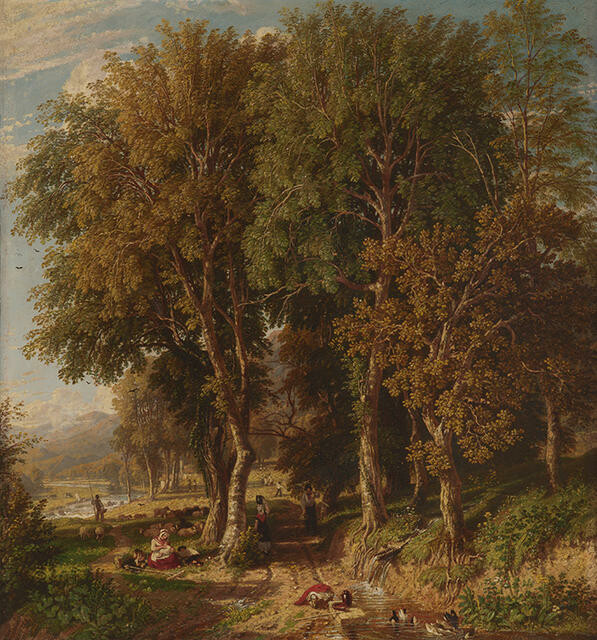William Havell
British, b.1782, d.1857
Scene near Ullswater
- 1826
- Oil on canvas
- Heathcote Helmore Bequest, 1965
- 685 x 650 x 45mm
- 69/363
- View on google maps
Tags: baskets (containers), birds (animals), children (people by age group), clouds, farming, infants, jugs (vessels), paths, people (agents), rakes, rivers, sheep, sunlight, trees
William Havell returned to England in 1826 after nine years abroad – firstly in China, followed by eight years in India and Ceylon (Sri Lanka). Suffering from the effects of cholera, he was described on his return as ‘an elegant man but much out of health’ by author Mary Russell Mitford. This atmospheric country scene was painted shortly after his return to England, and suggests the invigorating effect of the English Lake District in full summer. Swaying, feathery branches fill the frame; farm workers toil faithfully below; a woman carries water down a rutted, shady path; a nursing mother rests in sunlight. Reflecting the influence of Meindert Hobbema and Jacob van Ruisdael, it carries a wealth of detail. Look closely, and you’ll find sheep resting in shadow, sploshing ducks, bankside dandelions and trailing blackberry brambles.
(The Weight of Sunlight, 16 September 2017 - 16 September 2018)
Exhibition History
Until 2017 this work was thought to depict Grasmere and was shown with this label:
Lake Grasmere lies in the northern part of England’s Lake District, which William Havell had visited in 1802/1803. The sketches he made then were much later used as the basis for this work. The massing of foliage forms in the trees was characteristic of Havell’s treatment in both his watercolour and oil paintings. Being a studio work, Havell has introduced large numbers of figures to his composition for picturesque interest. After visiting Italy in 1827 these shepherds and farm workers became amore common feature of his work. Havell was born in Reading, England. In 1804 he was one of the original members of the Watercolour Society and began exhibiting at the Royal Academy. In 1816 Havell travelled with Lord Amherst’s embassy to China and, the following year, worked as a portrait painter in India and Burma. He returned to England in 1825 but, having lost touch with the art scene, died in poverty and obscurity. Havell is now seen as having an important place among English watercolourists.
(Label date unknown)

